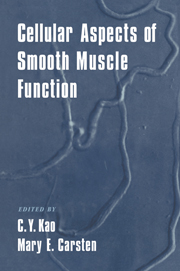Book contents
- Frontmatter
- Contents
- List of contributors
- Preface
- List of abbreviations
- 1 Morphology of smooth muscle
- 2 Calcium homeostasis in smooth muscles
- 3 Ionic channel functions in some visceral smooth myocytes
- 4 Muscarinic regulation of ion channels in smooth muscle
- 5 Mechanics of smooth muscle contraction
- 6 Regulation of smooth muscle contraction by myosin phosphorylation
- 7 Structure and function of the thin filament proteins of smooth muscle
- Index
3 - Ionic channel functions in some visceral smooth myocytes
Published online by Cambridge University Press: 04 August 2010
- Frontmatter
- Contents
- List of contributors
- Preface
- List of abbreviations
- 1 Morphology of smooth muscle
- 2 Calcium homeostasis in smooth muscles
- 3 Ionic channel functions in some visceral smooth myocytes
- 4 Muscarinic regulation of ion channels in smooth muscle
- 5 Mechanics of smooth muscle contraction
- 6 Regulation of smooth muscle contraction by myosin phosphorylation
- 7 Structure and function of the thin filament proteins of smooth muscle
- Index
Summary
Introduction
Smooth muscles subserve important physiological functions via the processes of membrane excitation, excitation-contraction coupling, and contraction. Until recently, their excitability properties have usually been understood only in broad generalities, because their small individual cells have been difficult to study with advanced electrophysiological methods. Much valuable information has been obtained through the use of impalement microelectrodes on cells enmeshed in their natural environment. However, the underlying ionic currents are poorly known, because applications of voltage-clamp methods to multicellular preparations are fraught with insuperable intrinsic obstacles. Successful isolation of viable individual smooth myocytes from amphibian tissues (Bagby et al. 1971; Fay and Delise 1973) and mammalian tissues (Momose and Gomi, 1980) opened the way to studying their cellular properties, first by use of impalement microelectrodes (Walsh and Singer 1980), and now more extensively by use of the tight-seal patch-clamp method (Hamill et al. 1981).
With rapid blossoming of investigations on cellular ionic channel functions of smooth myocytes, it is opportune to assess extant information in order to guide our perspectives. Because many new discoveries remain to be made, it may be well to recall that smooth myocytes do not function as isolated cells in their natural environment, and that a full view of the functions of the parent tissue or organ still requires considerations of the interplay of multitudes of single myocytes with one another, with their innervations, and with other types of cells among them. Moreover, because smooth myocytes are highly diverse in their properties, a true appreciation of the functions of a smooth muscle tissue requires knowledge of tissue-specific properties beyond general common features.
Information
- Type
- Chapter
- Information
- Cellular Aspects of Smooth Muscle Function , pp. 98 - 131Publisher: Cambridge University PressPrint publication year: 1997
Accessibility standard: Unknown
Why this information is here
This section outlines the accessibility features of this content - including support for screen readers, full keyboard navigation and high-contrast display options. This may not be relevant for you.Accessibility Information
- 5
- Cited by
